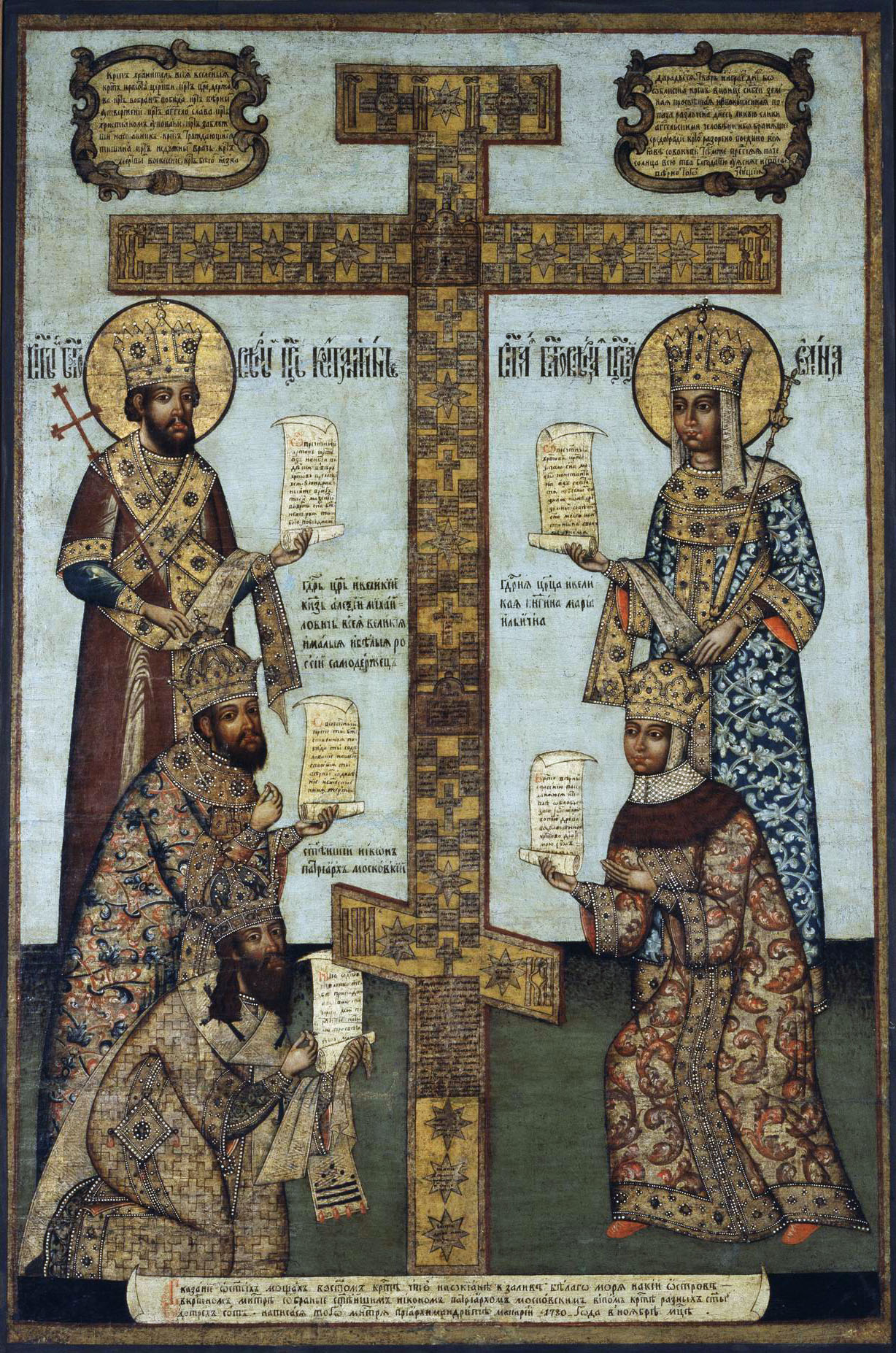- Bogdan Saltanov
Infobox Artist
bgcolour = #EEDD82
name = Bogdan (Ivan) Ievlevich Saltanov

imagesize = 150px
caption =Cross of Kiy of the Crucifix church inMoscow Kremlin . 1670s
birthname =
birthdate = 1630s
location =New Julfa
deathdate = 1703
deathplace =Moscow
nationality =Persia ,Russia
field =Icon s,engraving s, interior decoration
works =
patrons =Alexis I of Russia
awards =Bogdan Saltanov ( _ru. Богдан Салтанов, born in 1630s – died 1703Kazaryan, 1969, asserted that in 1703 Saltanov did not die, but left Russia and returned to Persia as Russian envoy. This assumption was refuted by subsequently fould archive evidence (Komashko, p.47).] in
Moscow ), also known as Ivan Ievlevich Saltanov, [Alternative name used by "Grabar"; later Russian sources unanimously use the name "Bogdan"] was an Armenian-born Russian painter at the court ofAlexis I of Russia and his successors. Saltanov headed the painting workshop of theKremlin Armoury since 1686. Saltanov's legacy include Orthodoxicon s for church and secular use,illuminated manuscript s, secularparsuna portraits including the portraits ofStepan Razin andFeodor III of Russia as a young man (see Attribution problem).Igor Grabar considered Saltanov and his contemporariesIvan Bezmin andVasily Poznansky as the fourth and the last class ofSimon Ushakov school, an "extreme left wing in the history of Russian icon art, the Jacobins whose art departed with the last traces of an already evaporated tradition" ( _ru. Они являются “крайней левой” в истории русской иконописи ушаковской эпохи — теми якобинцами, в искусстве которых исчезают последние следы и без того уже довольно призрачной традиции).Grabar, chapter XIII] Studies of 1990s–2000s partially refute this statement, asserting that Saltanov was substantially independent of Ushakov and his legacy. [Buseva-Davydova]Biography
In 1660 Zakar Sagradov, an Armenian trader from
New Julfa , serving as an envoy ofShah ofPersia , delivered Shah's gifts toTsar Alexis. The package included, among other items, an engravedcopper board depicting theLast Supper . The board aroused interest of the tsar who instructed Sagradov to return to Persia and hire the engraver into tsar's service. Muscovite artists were only experimenting with engravings on metal, and the tsar needed a professional to set up the new craft. The copper board was, most likely, a Western European product, however, Sagradov responded that he can hire at least an apprentice of the author. [Komashko, p.45. The story of Saltanov's hire and the engraving is based on two extant letters signed by the envoy Zakar Sagradov. One was addressed to Alexis, another to his minister Almaz Ivanov.] Six years later Saltanov, "the apprentice", arrived in Moscow with his brother, joined the staff of the Armoury and received a high salary. He was treated as a foreign noble, an honor rarely issued without reason. The artist converted to Russian Orthodoxy eight years later: conversion was equivalent to an oath of loyalty to the Romanovs and earned him the honors of a Russian noble, but also prevented the artist from ever leaving Russia. [Komashko, p.46, admits that the subject of Saltanov's conversion is disputed and cites alternative hypothesis.] His brother, Stepan Saltanov, also became a Russian noble, a treasurer of the Armoury and a founder of the Saltanov family. [Komashko, p.46]Bogdan Saltanov became the last court painter hired before the death of
Simon Ushakov , the undisputed leader of Muscovite art school. Ushakov rated Saltanov's skills as mediocre. Saltanov was the fourth foreign artist employed by the Moscow court (after theSwede Johann Deterson, hired in 1643, Pole Stanislaw Loputsky andDutchman Daniel Wouchters). When Stanislaw Loputsky, chief of the court painters, left Moscow in 1670s, his job was awarded toIvan Bezmin with Saltanov second in command; Saltanov took the lead in 1686 following repressions against Bezmin. All the Slavic chiefs of painters' workshop, including Simon Ushakov, were naturally born nobles, and apparently Saltanov was also recognized as such. [Komashko, p.48] Saltanov's earliest attested work were the "tafta icons" - icons painted on cloth with partial cloth application imitating garments of the saints. Igor Grabar suggested that this newgenre of icon was Saltanov's own invention owing to his Oriental roots, but admitted that the painting itself was mediocre. "These strange "tafta masters", so non-Russian in spirit, thought and feeling, terminated the history of Russian icon art" ( _ru. Этими странными “тафтяными мастерами”, столь нерусскими по всему своему духу, по всем мыслям и чувствам, закончилась история русской иконописи).Bezmin and Saltanov, as the workshop chiefs, were also teachers and mentors to the next generation of artists; there are 37 known trainees of Bezmin and 23 trainees of Saltanov, including
Karp Zolotaryov .Komashko, p. 48] Their status at the court was radically different from that of traditional icon painters: Saltanov's primary function was to provide secular art for the court, not the church. Even when the subject of a painting was clearly religious, its treatment was a step away from icon tradition into a "westernized", secular art. The earliest royal commissions of this kind (secular icons on copper and glass base) to Saltanov are attested to 1670 and 1671, and 1679 for Bezmin.Komashko, p. 48] As a result of this practice of 1670s, the professions of court painters and icon painters in Moscow nearly merged, with court painters actively taking over the icon painters' church jobs.
Wikimedia Foundation. 2010.
